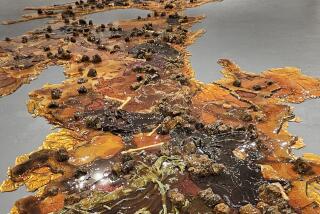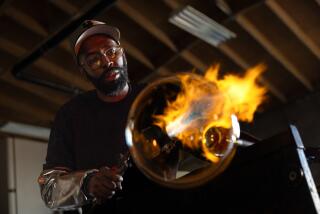Castoffs get second life in Michael McMillen’s hands
Michael McMillen describes the retrospective exhibition of his work now in its final weeks at the Oakland Museum of California as “40 years of experiments.” The choice of words is characteristically deliberate. Until part way through college, McMillen aimed to be a scientist, and a spirit of inquiry — physical, historical and perceptual — permeates his work. He conducts his investigations by way of storytelling, creating palpably convincing fictions in sculpture, installation, painting and film.
The process, especially when it comes to his immersive, room-size installations, often begins with McMillen writing a verbal sketch describing the experience he hopes to conjure — what he might see, hear and smell. The feel of gravel or loose planks underfoot. The quality of light. The temperature in the air.
“I’m always trying to take the viewer out of where they think they are and maybe move across time and put them someplace else for as long as they care to be there,” he says.
With “The Pavilion of Rain,” originally built in 1987 and reconstructed for the Oakland show, he transports us to a little shack pieced together out of corrugated metal, old windows, wooden shutters and metal grillwork, fragments of signs captioning the exterior. It sits in a broad, shallow pool cluttered with crates, wheel rims and buckets. Viewers cross a small footbridge to get inside, gauzy veils brushing their shoulders as they enter. A rain frame suspended from the ceiling showers the makeshift shelter on a regular cycle, 20 minutes on, 10 minutes off. McMillen built the installation, something of a late-20th century response to Kurt Schwitters’ “Merzbau,” as an homage to his father, a scenic artist for television who died the previous year.
“It’s night. It’s raining,” McMillen sets the scene. “We don’t know where we are. We’re more in nature than a city. The light coming off the water is fractured by the falling rain so it makes this beautiful, shimmering pattern wherever it’s reflected. That plus the sound of the rain hitting the roof and the water has a mesmerizing effect.
“That was part of my intent, to make something that had a meditative aspect, out of materials that you never associate with being calm. The materials are all decomposing, they’re rusting, they’re falling apart. They’re basically our societal detritus, junk that has been discarded and has no value, but when you bring them back together in this congress of matter, they take on meaning.”
The backyard of McMillen’s Santa Monica home is heaped with just such castoff parts and pieces: hinges, hoes and horseshoes; bedsprings and headboards; frying pans and strainers; a single oar, a puddle of chain; a breadbox filled with beakers and test tubes. Trumpet flowers climb the walls and dot the house with color. All within the yard is rust and dust, but just as fertile to McMillen, a lean, boyish 65, driven equally by earnestness and mischief.
The debris serves as raw material for sculptures and installations, and more of it is crammed into his adjacent two-story studio, where boxes shelved high above work tables are labeled “teeth,” “toys,” “human skeleton.” His work invariably appears aged, weathered, whether he’s using objects scavenged over the decades from nearby alleys, or things he’s made by hand, his skills honed by a dozen years building props and sets for Hollywood films as well as a more recent stint learning hand-lettered sign painting at a local trade school. A scuffed and padlocked trunk in the Oakland show bears a stained card identifying it mysteriously as “The Box of All Knowledge” (1997). Reverse peepholes in the doors of the “Red Trailer Motel” (2003) afford views into disheveled, abandoned spaces.
Assemblage artists of the ‘50s and ‘60s who resuscitated and recombined disparate discards were an obvious influence. More surprising is the early impact of work by Hans Burkhardt, one of his undergraduate professors at Cal State Northridge. What struck McMillen wasn’t Burkhardt’s well-known abstract paintings but the faux antiques the elder artist made on the side, constructing them from the worst wood he could find in the lumberyard.
“I really admired that and thought about it,” McMillen says. “It suited my needs, because I wanted to make things that appeared to have a previous life, a history. I wanted to imply that there was a story there.”
McMillen’s fascination with the past — real and imagined — owes much to the way he grew up, his frame of reference shifted backward a half-century by the grandparents who raised him after his parents’ divorce. His grandfather had served in World War I, and the shelves of his library were filled with books about the Civil War. Veterans of the second World War abounded in their neighborhood, many of them employed by the aerospace industry. As a kid, McMillen would pluck intriguing items from their trash — vacuum tube radios, an aviator’s cap — and wander up the alley to spend time in the workshop of a neighbor who had created special effects for “Frankenstein” and other films in the ‘30s. He was deeply imprinted by trips to the fading fun houses and decaying midways of Coney Island and Santa Monica, at once creepy, terrifying and attractive.
This rich stew of experiences and encounters has fueled McMillen’s work from the start, earning him exhibitions and accolades here and abroad.
“He didn’t grow up like a lot of people of his generation,” says Philip Linhares, curator of the Oakland show and a longtime friend. “He was kind of an isolated kid, growing up with older people, on his own, reading Popular Science magazine and making smoke bombs from his chemistry set. He’s dedicated to doing something not in the mainstream and has carried it out in such a thorough way. You can’t say there’s anything like the work. Artists respect it, and people that know nothing about art love it too.”
He staged his earliest full-scale project, “The Traveling Mystery Museum” (1973), in a storefront studio in Venice, complete with a ticket booth, postcards for sale and credible-seeming displays of the impossible. “If people took the time to read the fine print, they could see that it was a sham, but most people didn’t do that. They accepted it at face value, at first reading, and didn’t look any deeper. I thought that was a fascinating, almost anthropological study of how a culture sees or doesn’t see.”
For the past 10 years, McMillen has been devoting more of his time to filmmaking, there too fiddling with assumptions and expectations. He puts the movies together like collages, using footage and sound that he’s found and also recorded himself. Educational films he saw at school — “that told you how you could survive a nuclear blast by hiding under a chair” — continue to inspire, as do the disorienting European films he watched late at night after his grandparents had gone to bed. Some of his films last less than a minute. He likens them to haikus, but in effect they more closely resemble koans — concise conundrums, ticklish unanswered questions.
More to Read
The biggest entertainment stories
Get our big stories about Hollywood, film, television, music, arts, culture and more right in your inbox as soon as they publish.
You may occasionally receive promotional content from the Los Angeles Times.










